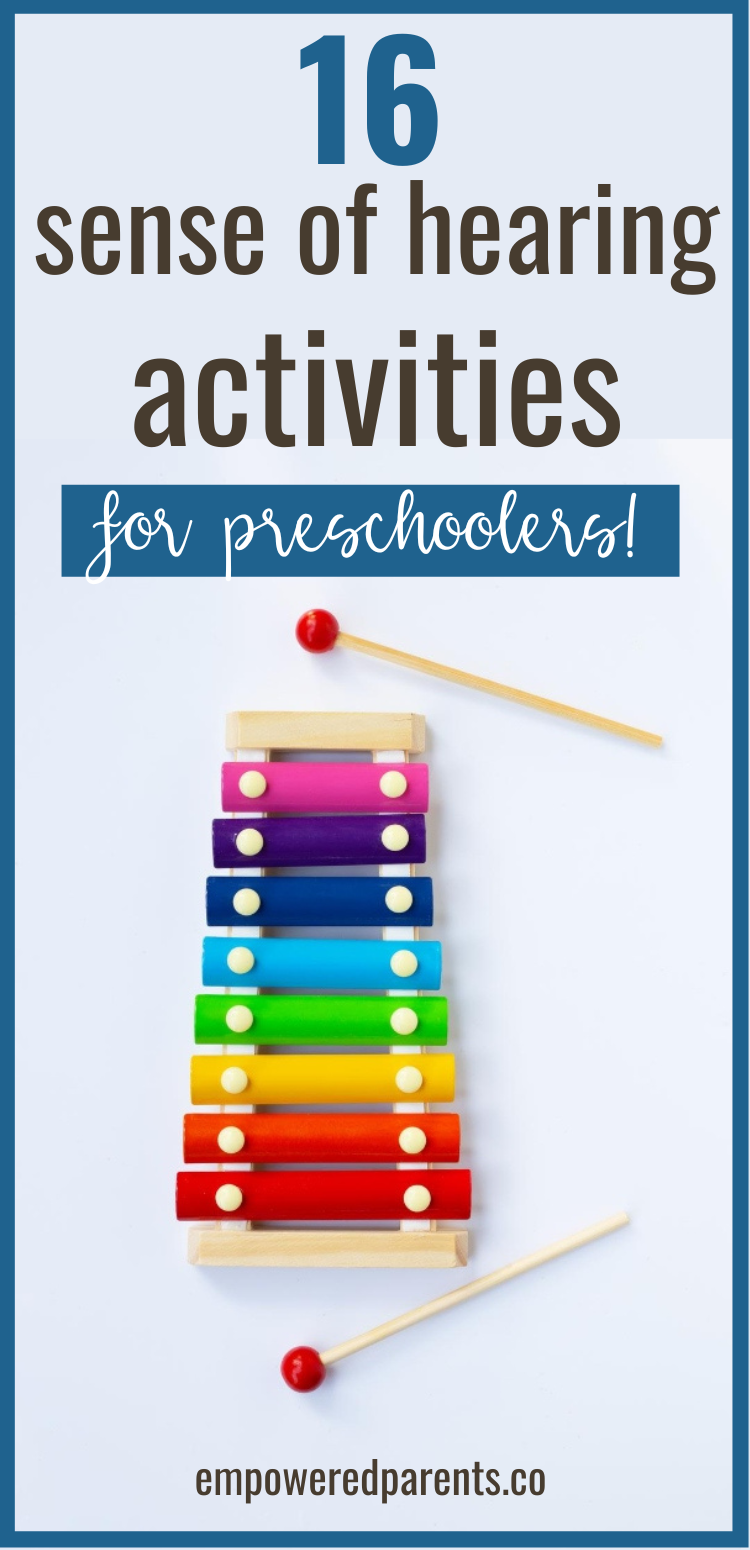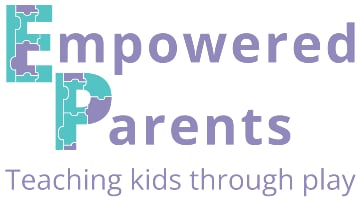These sense of hearing activities will help you explore hearing with children in a fun and engaging way.
Whether looking for sensory development ideas or aiming to teach the concept of senses through a preschool theme, these 16 activities are a great starting point.
1. Guess That Sound
Show children a variety of small objects: coins, sand, dry macaroni, paperclips, cotton balls and dry rice.
Allow the children to handle small buckets of these objects. Then, using plastic hollow eggs or balls, fill two of each with those same objects.
Encourage the children to shake them and find the eggs with matching sounds, while also guessing which objects are inside.
2. Match That Tone
Give children time to explore with play xylophones and mallets.

Once they are familiar with how they work, face the children and place a barrier between you. Play one note/tone at a time and challenge the kids to find the same note to play on their own xylophones.
3. Learn about Sign Language
Share picture books with children from the Moses Goes to series by Isaac Millman. Watch the read-aloud below.
The little boy, Moses, is deaf and communicates with his deaf friends through American Sign Language.
Children can learn the signs for a variety of words and concepts.
4. Learn about Hearing Aids
Share the picture book Gracie’s Ears by Debbie Blackington.
This rhyming story follows a little girl who is hearing challenged as she is fitted for hearing aids and then experiences the wonders of hearing everything around her.
5. Go on a Hearing Hike
Go on a hike in the park, neighbourhood, or garden.
Challenge the children to listen for and name the sounds they hear: birds singing, cars driving past, an airplane moving across the sky, a fire engine in the distance, or a train chugging along the tracks.

Especially if the source is something they cannot see, encourage kids to use describing words that explain the sounds they hear.
6. Noise Detectives
Make various sounds using objects around the house or classroom, and have the children guess what is making the noise.
Ideas include:
- Running water into a pot
- Zipping a jacket
- Opening and closing a door
- Placing toys in baskets
- Picking up keys
- Closing the window blinds.
7. Loud and Soft
Using catalogues and magazines with plenty of pictures, ask the children to cut or tear out images of things that make noise.
After each child has collected examples, make a poster with the word “loud” on one side and “soft” on the other.
Decide as a group in which category each picture’s sound fits the best and have the children help to tape or glue them in that position.
8. Drum Parade
Marching to music, children beat on toy drums or those made from various saved containers.

Challenge them to find things around the room or home to use as drumsticks to make different types of sounds, such as:
- Cardboard tubes
- Pipe cleaners
- Drinking straws
- Plastic spoons
Which sounds are the loudest or quietest? Which sounds do they like the most?
9. Dance to the Beat
Show children how to listen to various music clips and then move/dance in a matching fashion: slow, fast, floating, sleepy, jazzy, spooky and ballet-like.

Then, play short pieces of music for the children to hear and respond to by moving in ways that match the beat.
10. Play Telephone
Whisper a word or short phrase into one child’s ear, and they will repeat it to the next child in line. This continues until the last person who has heard the message says it aloud.
The kids are often surprised to discover that the message has been misunderstood and changed!
Here are 100 Telephone Game phrases to try.
11. Science of Sound
How do you explain hearing to a child? Begin with exploring the concept of sound!
Sounds All Around: The Science of How Sound Works by Susan Hughes explains the vibration of sound to young kids and shows how that relates to our hearing.
12. Make Musical Instruments
For a fun sense of hearing arts and crafts project, provide a variety of materials for the children to make their own musical instruments.
For example, save those paper towel cardboard rolls and have the kids cover them with shiny aluminium foil, then decorate them with coloured paper or tissue paper snippets.
Children can also decorate plain paper plates cut in half with markers, crayons or coloured paper. Tape two halves together, filling them with dried peas, beans, or rice before securing the final opening to make maracas.
Search the web for ideas of other fun handmade instruments.
13. Who Said Moo?
Get children to practise listening to animal sounds by making one sound at a time and asking them to guess who makes that noise.
Include sounds of pets, neighbourhood animals, forest creatures, jungle animals, and even some ocean animals that make noise.

14. I Hear with My Little Ear
I Hear with My Little Ear is a variation of “I Spy with My Little Eye” that gives children a chance to think about different kinds of sounds.
Some sounds are loud, soft, fast, sad or even scary!
15. Listener Copy Cats
Clap or beat out a simple rhythm pattern for the children who are listening carefully. Challenge them to copy that very same rhythm.
The kids can then take turns being “the leader” for the other kids to copy.
16. Draw Listening Pictures
Learning to be an attentive listener is an essential aspect of hearing development for young children.
Give each child a blank sheet of paper with a pencil. Tell a story that includes directions for what they should draw on their papers, one step at a time.
They can colour their pictures once the basic drawings are complete.
Here are some listen-and-draw ideas to get you started.
Beyond hearing and auditory perception, focusing on each of the following is essential for children’s sensory development, whether through planned activities or guided sensory play.
Check out the fun for each of these areas:
- Sight
- Touch
- Smell
- Taste
- Balance (vestibular)
- Body awareness (proprioception)

